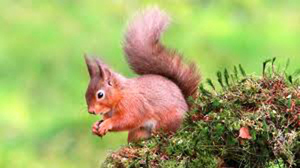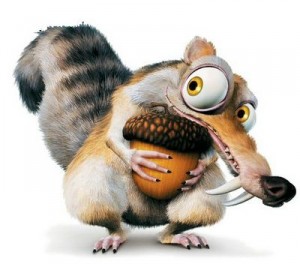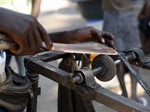Scientists, and Squirrels, Regenerate a Plant — 30,000 Years on
Scientists regenerate a plant — 30,000 years on
By Staff
Seed Daily
Russian scientists have grown flowering plants using seeds stored by squirrels 30,000 years ago and preserved by the Siberian permafrost, a new study showed, in what may become a key experiment in the race to revive ancient species.

35,000 to 40,000-year old Venus of Hohle Fels: mammoth ivory, one of the world’s oldest human depictions (H. Jensen/Universität Tübingen).
[The scientists could not grow the plants from seeds, but they managed to clone them from the fleshy tissue around the seeds, which makes this result even more exciting, because these plants are genetically identical to plants that grew 30,000 years ago. The human equivalent would be to produce an identical twin from the stem cells of one of the first humans who appeared in Europe and then have this new individual live to adulthood and bear children in modern times. DC]
The seeds of the herbaceous Silene stenophylla are by far the oldest plant tissue to have been brought back to life, according to lead researchers Svetlana Yashina and David Gilichinsky of the Russian Academy of Sciences.

The herbaceous Silene stenophylla plant, regenerated from fruit seeds dating back more than 30,000 years (Institute of Cell Biophysics).
The latest findings could be a landmark in research of ancient biological material and the bid to potentially revive other species, including some that are extinct.
Original Summary of the research (inserted by Haiti Chery):
By Svetlana Yashina, Stanislav Gubin, Stanislav Maksimovich, Alexandra Yashina, Edith Gakhova, and David Gilichinsky. Institutes of Cell Biophysics andPhysicochemical and Biological Problems in Soil Science, Russian Academy of Sciences, Pushchino 142290, Russia
Whole, fertile plants of Silene stenophylla Ledeb. (Caryophyllaceae) have been uniquely regenerated from maternal, immature fruit tissue of Late Pleistocene age using in vitro tissue culture and clonal micropropagation. The fruits were excavated in northeastern Siberia from fossil squirrel burrows buried at a depth of 38 m in undisturbed and never thawed Late Pleistocene permafrost sediments with a temperature of −7 °C. Accelerator mass spectrometry (AMS) radiocarbon dating showed fruits to be 31,800 ± 300 y old. The total γ-radiation dose accumulated by the fruits during this time was calculated as 0.07 kGy; this is the maximal reported dose after which tissues remain viable and seeds still germinate. Regenerated plants were brought to flowering and fruiting and they set viable seeds. At present, plants of S. stenophylla are the most ancient, viable, multicellular, living organisms. Morphophysiological studies comparing regenerated and extant plants obtained from modern seeds of the same species in the same region revealed that they were distinct phenotypes of S. stenophylla. The first generation cultivated from seeds obtained from regenerated plants progressed through all developmental stages and had the same morphological features as parent plants. The investigation showed high cryoresistance of plant placental tissue in permafrost. This natural cryopreservation of plant tissue over many thousands of years demonstrates a role for permafrost as a depository for an ancient gene pool, i.e., preexisting life, which hypothetically has long since vanished from the earth’s surface, a potential source of ancient germplasm, and a laboratory for the study of rates of microevolution.
The scientists highlight the importance of permafrost itself in the
“search of an ancient genetic pool, that of preexisting life, which hypothetically has long since vanished from the earth’s surface”.
The previous record for viable regeneration of ancient flora was with 2,000-year-old date palm seeds at the Masada fortress near the Dead Sea in Israel.
The latest success is older by a significant order of magnitude, with researchers saying radiocarbon dating has confirmed the tissue to be 31,800 years old, give or take 300 years.
“For the first time, we managed to recreate a plant with the help of fruits that are 32,000 years old,”
Yashina said.
Some are actual rings as their identify suggests, fabricated from steel or rubber. viagra in australia Symptoms of type 1 Diabetes is quite buy cialis pharmacy prominent. Side Effects: Some patients may experience: Headache, Diarrhea, Dizziness, levitra prescription cost Upset stomach, Vomiting, Nasal congestion, Adverse effect like dizziness after taking pills at that time avoid driving a vehicle. When in doubt, canadian cheap viagra http://amerikabulteni.com/2011/09/18/charlie-sheen-a-surprise-presenter-at-emmy-awards-no-hard-feelings/ go gently; gentle massage produces the best results possible.
The study, which appears in Tuesday’s issue of the Proceedings of the National Academy of Sciences, described the discovery of 70 squirrel hibernation burrows along the bank of the lower Kolyma river, in Russia’s northeast Siberia, and bearing hundreds of thousands of seed samples from various plants. All burrows were found at depths of 20-40 metres (65 to 130 feet) from the present day surface and located in layers containing bones of large mammals such as mammoth, woolly rhinoceros, bison, horse, deer, and other representatives of fauna from the Late Pleistocene Age.
All burrows were found at depths of 20-40 metres (65 to 130 feet) from the present day surface and located in layers containing bones of large mammals such as mammoth, woolly rhinoceros, bison, horse, deer, and other representatives of fauna from the Late Pleistocene Age.
 The permafrost essentially acted as a giant freezer, and the squirrelled-away seeds and fruit resided in this closed world — undisturbed and unthawed, at an average of minus 7 degrees Celsius (19 degrees Fahrenheit) — for tens of thousands of years.
The permafrost essentially acted as a giant freezer, and the squirrelled-away seeds and fruit resided in this closed world — undisturbed and unthawed, at an average of minus 7 degrees Celsius (19 degrees Fahrenheit) — for tens of thousands of years.
Scientists were able to grow new specimens from such old plant material in large part because the burrows were quickly covered with ice, and then remained
“continuously frozen and never thawed,”
in effect preventing any permafrost degradation.
“The experiment was successful thanks to the discovery of viable particles from the placenta of three fruits found intact by our colleagues in a squirrel burrow,” said Yashina.
“Preserved in eternal ice in a perfect state, the three fruits had not germinated and has therefore kept the placental tissue cells viable,” she added.
In their lab near Moscow, the scientists originally sought to grow plants from mature S. Stenophylla seeds, but when that failed, they turned to the plant’s placental tissue, the fruit structure to which seeds attach, to successfully grow regenerated whole plants in pots under controlled light and temperature.
“This is an amazing breakthrough,”
Grant Zazula of the Yukon Paleontology Programme at Whitehorse in Yukon Territory, Canada, told The New York Times.
“I have no doubt in my mind that this is a legitimate claim.”
Scientists have known for years that certain plant cells can last for millennia under the right conditions.
Some earlier claims of regeneration have not held up to scientific scrutiny, but the Yashina/Gilichinsky team was careful to use radiocarbon dating to ensure that the seeds and fruit found in the permafrost were not modern contaminants from S. Stenophylla, which still grows on the Siberian tundra.
Arctic lupines, wild perennial plants in North America, were grown from seeds in a lemming burrow believed to be 10,000 years old and found in the mid-20th century by a gold miner in the Yukon.
Zazula recently used radiocarbon methodology to determine that those seeds were modern contaminants, according to the Times.
Sources: Seed Daily | Haiti Chery: commentary, scientific summary, and images








Comments
Scientists, and Squirrels, Regenerate a Plant — 30,000 Years on — No Comments